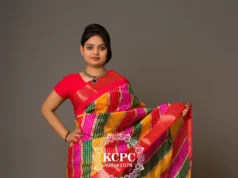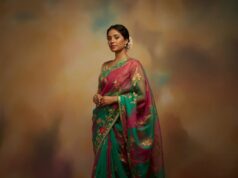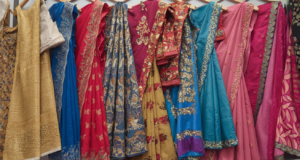In recent years, the fashion world has witnessed a remarkable phenomenon: the resurgence of the saree, India’s timeless traditional garment, as a powerful force in contemporary fashion. What was once considered solely traditional attire has transformed into a versatile fashion statement embraced by designers, celebrities, and fashion enthusiasts worldwide. This revival isn’t just about nostalgia—it represents a meaningful fusion of heritage and innovation that’s reshaping the global fashion landscape.
The Renaissance of Traditional Weaves
The heart of this saree revival lies in the renewed appreciation for traditional weaving techniques. Handloom sarees from regions like Banarasi, Kanjeevaram, Chanderi, and Jamdani are experiencing unprecedented demand. These heritage textiles, once at risk of being forgotten in the fast fashion era, are now celebrated for their craftsmanship, sustainable production methods, and cultural significance.
Artisans who have preserved these techniques through generations are finding new markets and recognition. Their intricate work—whether it’s the gold zari of Banarasi silk or the buttas of Kanjeevaram—is being appreciated not just for its aesthetic beauty but as living heritage. Fashion labels and government initiatives alike are working to support these craftspeople, ensuring these traditional skills continue to thrive.
Modern Interpretations: The Designer Revolution
Contemporary designers have played a pivotal role in reimagining the saree for modern sensibilities. Designers like Sabyasachi Mukherjee, Manish Malhotra, and Raw Mango’s Sanjay Garg have brilliantly bridged the gap between traditional craftsmanship and contemporary design aesthetics.
These designers are experimenting with:
- Unconventional draping styles that create modern silhouettes
- Fusion elements that combine Western and Eastern design sensibilities
- Unexpected color palettes that break away from traditional combinations
- Innovative blouse designs that transform the overall look
The result is a garment that honors its roots while feeling completely relevant to today’s fashion-forward woman.
Celebrity Influence: From Red Carpets to Global Stages
Celebrities have become powerful ambassadors for the saree renaissance. When Deepika Padukone graced the Cannes Film Festival in a stunning white and gold saree, or when Priyanka Chopra Jonas wore a hand-embroidered piece to international events, they showcased the garment’s elegance on the global stage.
Social media has amplified this influence, with celebrity saree looks going viral and inspiring millions. These high-profile appearances have helped position the saree not as ethnic wear but as a sophisticated, global fashion choice that can hold its own alongside designer gowns on international red carpets.

Sustainability: The Timeless Appeal of Slow Fashion
In an era increasingly concerned with fashion’s environmental impact, the saree stands out as inherently sustainable. Its one-size-fits-all nature eliminates sizing waste, while its timeless design transcends seasonal trends. Traditional sarees are often passed down through generations, embodying the principles of slow fashion long before the term was coined.
The durability and versatility of quality sarees make them ideal investments in a sustainable wardrobe. A single saree can be styled differently for multiple occasions, reducing the need for excessive consumption. This aspect has particularly resonated with environmentally conscious consumers looking to make more responsible fashion choices.
Digital Transformation: Social Media and E-commerce
The digital revolution has dramatically accelerated the saree revival. Instagram accounts dedicated to saree appreciation have millions of followers, while hashtags like #SareeNotSorry and #100SareePact have created vibrant online communities celebrating the garment.
E-commerce has democratized access to regional weaves that were once difficult to source outside their areas of production. Now, a customer in New York can purchase an authentic Pochampally ikat saree directly from weavers in Telangana, or a shopper in Tokyo can browse through Bengal’s finest Jamdani collections.
The Global Crossover
Perhaps most exciting is how the saree is influencing global fashion. International designers have incorporated saree-inspired draping in their collections, while fusion experiments have led to innovations like the “saree gown” and “saree pants.” Fashion capitals like Paris and Milan have featured saree-inspired silhouettes on their runways, signaling the garment’s arrival as a global fashion influence rather than just a cultural costume.
The Future: Innovation Within Tradition
As we look ahead, the saree’s journey suggests a future where tradition and innovation continue to intertwine. The next frontier includes:
- Experimenting with sustainable, innovative fabrics that maintain the saree’s essence
- Technology integration, such as smart textiles that adapt to weather conditions
- Continued evolution of draping styles for different body types and occasions
- Greater global crossover, with more international adaptations and interpretations
Conclusion: More Than Just a Garment
The saree revival represents something more profound than a fashion trend. It symbolizes a cultural reclamation—a generation embracing their heritage on their own terms. It embodies the perfect balance between honoring tradition and embracing change.
In a world often divided between preserving the past and rushing toward the future, the modern saree renaissance offers a third path: carrying forward the best of our traditions while fearlessly reimagining them for contemporary times. As this beautiful garment continues its evolution, it remains a powerful reminder that fashion at its best doesn’t just clothe us—it connects us across time, culture, and generations.
The six yards of fabric that make up a saree contain within them stories of artistry, heritage, and identity. In its modern revival, the saree isn’t just reshaping fashion—it’s redefining how we think about the relationship between tradition and innovation in our globalized world.













Hello! I know this is kinda off topic but I’d figured I’d ask.
Would you be interested in exchanging links or maybe guest authoring a blog article or vice-versa?
My website discusses a lot of the same subjects as yours and I
think we could greatly benefit from each other. If you are interested feel free to shoot me an e-mail.
I look forward to hearing from you! Terrific blog by the way!
okay plz talk on mail